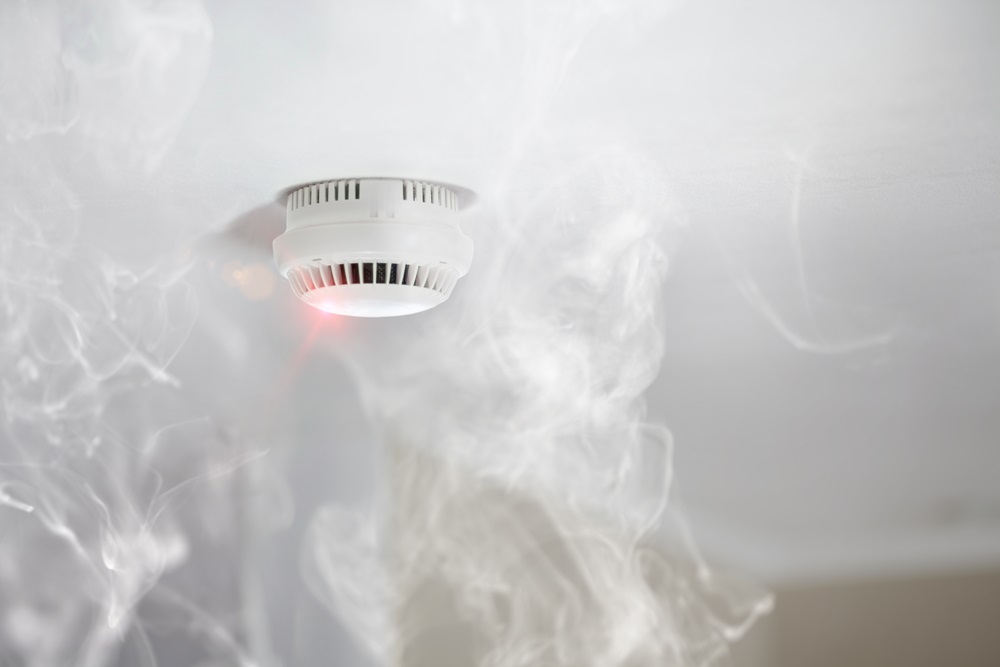Disclosure: In any review for a product or service, products or compensation may have been provided to me to help facilitate my review. All opinions are my own and honest. I am disclosing this in accordance with FTC Guidelines. Please see “Disclose” and "Terms of Use" tabs for more information.

Smoke alarms are an important part of monitoring the safety of your home. As many as two-thirds of all fire related deaths occur in homes without smoke detectors, or with smoke detectors that are not functioning due to improper maintenance. In order to reduce death and injury, you need to have enough smoke detectors throughout your house, and to make sure that they are installed properly.
Types Of Smoke Alarms
There are three primary types of smoke alarm: Ionization, photoelectric and combination.
- Ionization Alarms – Ionization alarms contain small amount of radioactive material that creates an electric current within the alarm. When smoke enters the detector, it disrupts the current, causing the alarm to sound. These smoke detectors are best at detecting fast-burning fires.
- Photoelectric Alarms – Detect smoke by using a light source. The light becomes scattered by smoke particles, activating the alarm. Photoelectric alarms are better for detecting slow-burning fires with low flames.
- Combination Alarms – As the name suggests, combination alarms combine both technologies in order to detect both category of fire. Fire protection units recommend using combination alarms, or to install both types of alarms throughout your home.
Older models of smoke alarms are actually heat detectors. They are not as effective at rapidly detecting fires as the more modern alarm types.
Carbon Monoxide Detectors
With modern alarms you also have the option of getting a combination smoke and carbon monoxide detector. You should also have a carbon monoxide alarm on each floor of your home if you have any fuel-burning appliances. Purchasing a unit that is able to detect both can reduce the amount of total units you need to install throughout your home.
Alarm Placement
For optimal protection, you will need multiple smoke alarms. Most homes don’t have nearly as many smoke alarms installed as is recommended.
Smoke alarms should be installed:
- On every floor of the home, including the basement
- Inside each bedroom
- Outside of each bedroom – one in the hall outside multiple bedrooms is alright
Be sure to read the manufacturer’s instructions on the unit that you purchase to determine whether the detector should be installed on the wall or on the ceiling. The most common units require ceiling installation with a few feet of space between the detector and the wall.
The instructions will also inform you how much square footage the alarm covers. If you purchase less powerful detectors you will need to install more of them throughout you home.
Connecting your fire alarms with an interconnected alarm system can also be important, especially for large homes. In an interconnected system, if the alarm sounds in the basement, the alarms by the second floor bedrooms will also sound, providing you with an early alert.
Alarm Maintenance
Smoke alarms may be powered differently and therefore require different maintenance. Testing on a weekly, or at least a monthly basis, can help to ensure that your alarms are functioning and will detect smoke in the case of a fire.
Alarms powered by 9-volt batteries are common due to their low cost. The downside to these alarms is that the batteries need to be replaced frequently. Weekly testing is recommended for optimal safety with these alarms, or to change the battery twice per year in combination with monthly testing.
You can also purchase alarms that take a 120-volt battery or a 10-year lithium battery. While these are more pricey, they are more reliable. Some townships require a minimum 120-volt battery.
If you are living in an older home, you will likely need to install more alarms, and may need to replace any existing ones. Check the existing models to see if they are heat detectors, rather than smoke detectors. If they are heat detectors – you should replace them with smoke detectors or install additional smoke detectors for optimal safety.
Conclusion
In order to protect yourself and loved ones from fire and carbon monoxide injury, smoke and carbon monoxide detectors need to be installed throughout your home. Do your research when selecting alarm units and be sure to purchase different types of detectors, or opt for a combination alarm. You should also make sure that the units you purchase have been tested by a recognized laboratory to ensure efficacy.
Install your alarms per the manufacturer’s instructions and make sure that you have enough throughout your home. With proper maintenance and battery monitoring, you will be as safe as possible in your home!
Joanna Sommer
Joanna is the Senior Editor for InformedMag and is passionate about security and tech. She has been working in the home safety and security field for 5 years. Joanna loves to travel and enjoys going to hot yoga and Barre classes. She is dedicated to creating articles that both educate and help people make an informed purchasing decision.
















Speak Your Mind